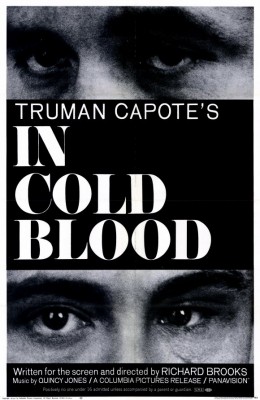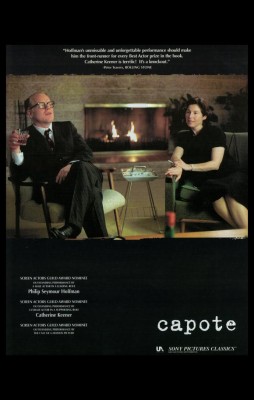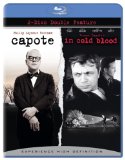| Reviews & Columns |
|
Reviews DVD TV on DVD Blu-ray 4K UHD International DVDs In Theaters Reviews by Studio Video Games Features Collector Series DVDs Easter Egg Database Interviews DVD Talk Radio Feature Articles Columns Anime Talk DVD Savant Horror DVDs The M.O.D. Squad Art House HD Talk Silent DVD
|
DVD Talk Forum |
|
|
| Resources |
|
DVD Price Search Customer Service #'s RCE Info Links |
|
Columns
|
|
|
Capote / In Cold Blood
Though In Cold Blood disappointingly lacks extra features, the transfer is one of the best this reviewer has ever seen. Capote, meanwhile, has a fair amount of supplements, all from the 2006 DVD. For some, In Cold Blood will play like a great extra feature bolstering Capote, while others (this reviewer included) with think just the reverse, that Capote is like an interesting addendum to In Cold Blood. What's more, the discs are A/B/C-encoded, effectively region-free.
A faithful adaptation of Capote's landmark non-fiction novel, itself a starkly authentic account of real-events, In Cold Blood traces the planning and botched execution of a "sure thing" home invasion robbery that instead becomes a notorious cold-blooded murder of an ordinary Midwestern family. Partly it's a psychological study of the two murderers, partly it's a police procedural.
November 15, 1959: Two ex-cons on parole, Dick Hickock (Scott Wilson) and Perry Smith (Robert Blake) drive 400 miles to break into the remote farmhouse of Herb Clutter (John McLiam), his wife and teenage son and daughter - people neither Hickock nor Smith have ever met. The two robbers mistakenly believe Clutter has a safe secretly tucked away in his home containing at least $10,000; in fact he had no safe at all. The family is brutally murdered while Hickock and Smith flee with just $43, a radio, and a pair of binoculars.
An investigation of the crime is led by Kansas Bureau of Investigation Agent Alvin Dewey (John Forsythe) and associate Harold Nye (Gerald S. O'Loughlin), while a reporter based on Capote, Jensen (Paul Stewart), follows the case.
Released on December 14, 1967, just prior to the implementation of the MPAA's ratings system, In Cold Blood was originally "suggested for mature audience" (later rated "R" for its reissue in 1970) and reflects the general shift toward more explicit content. (Reportedly it was the first American film to include the word "bullshit," though use of the word "shit" goes at least as far back as Laurel & Hardy's 1929 short Perfect Day*.)
Nevertheless, In Cold Blood's capital crimes are deeply disturbing without ever resorting to graphic violence at all. The victims are largely off-camera as they're being murdered, and much less blood is seen than the average contemporaneous Hammer horror film. (Contrastingly, the much more graphic Dracula Has Risen from the Grave, made the following year, actually got a "G" rating.) In fact what's disturbing about In Cold Blood's murders is that the violence is so casually perpetrated against total strangers, an innocent family seemingly chosen at random and murdered for chump change, a family that fully complied with their captors demands - the father remains cool and collected throughout - and yet they still were slaughtered like animals.
The disturbing nature of the murders is accentuated by writer-director Richard Brooks's use of most of the real locations, including the Clutter's actual farmhouse, and the use of many non-actors playing themselves: the original jurors, townsfolk, etc. The late, great cinematographer Conrad Hall shoots the picture in a semi-documentary (though also lyrical) style, in black and white, which adds to the immediacy, as do the experienced but relatively unknown actors - neophyte Wilson; former child actor Blake, in his first major adult role; and Will Geer and Jeff Corey, both character actors absent for years on account of the blacklist. Except for John Forsythe, the cast would have been unknown to most moviegoers. (And isn't that an uncredited Rosie Grier as one of the two men Smith and Hickcock decline hitchhiking a ride with?)
Wilson is creepily convincing as the utterly amoral Hickock, but it's Blake's uncontrollably-spiraling-toward-doomsday Perry Smith who engenders our sympathy. Insufferable as a member of "Our Gang" and unconvincing in John Huston's masterly Treasure of the Sierra Madre (referenced several times in the film, but not as an in-joke; it happened to be Smith's favorite film) Blake's performance here is a revelation. It was, by all accounts, tailor-made. Like Smith Blake had an abusive, alcoholic father (Smith's is superbly played in In Cold Blood by the great noir actor Charles McGraw), left home as a teenager, served in Korea, and was subject to mood swings that could turn on a dime. In 2001, Blake was himself arrested and tried for the murder of his wife. Though ultimately acquitted, he later lost a civil case of wrongful death.
One assumes Blake could relate strongly to this unhappy man and his unhappy life - additionally, Smith's mother was an alcoholic, and two of his siblings committed suicide - but whatever the reason it's a sensitive performance, alternately naïve and self-aware, electrifying and heartbreaking.
One of the most ingenious aspects of the film version is its structure. (A device carried over from the book? It's been more than 25 years since I read it.) The picture opens with the events leading up to the point where Hickock and Smith arrive at the Clutter farm house. Smith, aware of what's about to transpire, begs Hickock, "Let's pull out of here before it's too late." There's a cut and suddenly it's the morning after, and the bodies are discovered by friends of the family. It's not until relatively late in the film, well after the men's capture, that via Smith's confession the specifics of that unspeakable night are shown by which time the audience, having become aware of its outcome and impact, brace themselves for the worst. In other words, the reshuffling of events away from a purely chronological, conventional narrative structure accentuates its impact, and also by delaying showing the murders until after the audience has been exposed to flashbacks from Smith's early life and regret after the fact, the senseless act of violence becomes slightly more understandable while at the same time more tragic and horrible.
Though close to perfection, In Cold Blood does have a few flaws. There's an overused editing gimmick linking disconnected scenes with a sound effect, an object, or a line of dialogue - for instance a telephone will ring at the end of one scene and then ring at the beginning of an otherwise disconnected scene immediately following. The distinctive voice actor Paul Frees is heard so often that after a while it becomes comical, like he's one man who really gets around, turning up as a radio and television announcer, a newspaper reporter, one of the jurors, and as the voice of a prison warden. (Film rating: *****)
Capote was one of two films covering virtually the same territory; the other was Infamous (2006), released almost exactly one year later, with Toby Jones as Capote. Actor Philip Seymour Hoffman stole Jones's thunder, however, winning numerous awards for Capote, and the film itself was highly praised.
And yet Capote is a major disappointment. Outwardly, the film seems to focus on the complex nature of Capote's relationship with the condemned Perry Smith (Clifton Collins, Jr.), long a subject of much speculation. What was the exact nature of their relationship - merely researcher and subject? Intimate friends? Did they fall in love with one another?
But the film doesn't really tell its audience anything new about Capote, and offers virtually no insight at all about Smith. Capote is depicted in familiar terms - the small man with the colossal ego, the popular and salacious raconteur with the nasally affectations. Actor Dan Futterman's screenplay (from Gerald Clarke's book) depicts him as far more sensitive and reserved than usual, and Hoffman plays that interpretation well. On one hand Capote finds a kindred spirit in Smith: "It's as if Perry and I grew up in the same house," he says. "And one day he stood up and went out the back door, while I went out the front."
And yet Capote is also a great user. He uses and manipulates and lies to Smith to get what he wants, the sensational elements of the book he's trying to finish. And when he doesn't "have an ending," he secretly hopes the two men will be put to death while simultaneously providing them lawyers and claiming to be on their side.
All this is extremely promising material but it's not developed as deeply or as carefully as it might have been. It doesn't compare favorably to Jay Presson Allen's wonderful 1989 play Tru, with Robert Morse so mesmerizing in the title role. While the argument can be made that Capote isn't so much about the writer's relationship with Perry as it is about Capote's reaction and inner-turmoil to that relationship, and that the screenplay reflects Capote's self-absorbed nature, the scenes with Smith can't help but pale compared to the film of In Cold Blood. In one sense, Capote's presence is more strongly felt in In Cold Blood even though he's not technically in it, but instead his voice comes through in its depiction of Smith especially, and even though actor Robert Blake is more familiar to most audiences than Collins, Blake's Smith is not only more fully formed he never seems like an actor playing a role, which Collins does throughout Capote.
The film is sloppy in other respects, such as ignoring well-known specific facts of the case. For instance, in Capote Truman witnesses only Smith's execution but in fact he saw only Hickock's. And there's also a lot of footage of Capote at the typewriter, despite the fact that Capote never apparently used one, that he always wrote everything out in long-hand. There's a lot of this sort of thing, which only undermines the film's ambitions of a more truthful look at its subject.
Like the real Capote, Capote frequently name-drops. Capote talks about working on Beat the Devil and his cousin "Tennessee," while close friend "Nell" Harper Lee (Catherine Keener) plays a major role in the film, though her To Kill a Mockingbird becomes almost like a running gag, with the politely curious asking questions like, "What's that 'Bird-Killing' children's book thing you're doing?" The film also makes the mistake of trying to dramatize, even "top" the killing of the Clutter family, which is more graphic and much less chilling than In Cold Blood. (*** 1/2)
Video & Audio
Filmed in 2.35:1 Panavision with original prints by Technicolor, the black & white In Cold Blood is an absolutely stunner on Blu-ray disc - one of the best-looking transfers this reviewer has ever seen. Both the monochrome photography and Conrad Hall's great cinematic eye - especially for its extensive night-for-night lensing - help enormously, but the transfer is razor sharp and virtually flawless; it looks like it could have been shot yesterday, and the video gets a rare 5-star rating from this reviewer. The 1080p transfer also features English and French Dolby TrueHD 5.1 sound, though except for a few directional sound effects, the new audio is modest and doesn't overwhelm the picture, though it helps bring out Quincy Jones' score somewhat. Optional subtitles in English, English SDH, French, Arabic, and Dutch are included, but curiously not Spanish. (Why?)
Capote looks fine in its 2.35:1/1080p transfer, its muted color pallet, with an emphasis on autumnal colors (with numerous shots of leafless trees against gray skies). Dolby TrueHD 5.1 tracks are available in English, French, and Portuguese, with a Spanish 5.1 track also included, as well as subtitles in English, English SDH, French, Spanish, Portuguese, Arabic, and Dutch. The bonus features are subtitled in French, Portuguese, Spanish, and Dutch only.
Extra Features
Sadly, In Cold Blood has no supplements at all, and Capote's are all in standard-def from the March 2006 DVD. They include an okay two-part Making of 'Capote', a too-brief Answered Prayers, a "documentary" on Capote but more like a super-short featurette. Also included are two somewhat redundant Audio Commentaries, the first with director Bennett Miller and Philip Seymour Hoffman, the second with Miller and cinematographer Adam Kimmel.
Parting Thoughts
Though disappointing, Capote is definitely worth seeing once, while In Cold Blood is a masterpiece that's never looked better than it does on Blu-ray disc. This is a very worthwhile package, and despite the absence of new extras, taken together this gets a DVD Talk Collector Series rating.
* It's true. The families of Laurel & Hardy have planned on a drive/picnic on a Sunday, the Sabbath. When "Uncle" Edgar Kennedy spots a minister walking toward them, Kennedy says, "Oh shit!" and everyone runs back inside the house to hide. No Foolin'.
Film historian Stuart Galbraith IV's latest book, The Toho Studios Story, is on sale now.
|
| Popular Reviews |
| Sponsored Links |
|
|
| Sponsored Links |
|
|
| Release List | Reviews | Shop | Newsletter | Forum | DVD Giveaways | Blu-Ray | Advertise |
|
Copyright 2024 DVDTalk.com All Rights Reserved. Legal Info, Privacy Policy, Terms of Use,
Manage Preferences,
Your Privacy Choices | |||||||
















